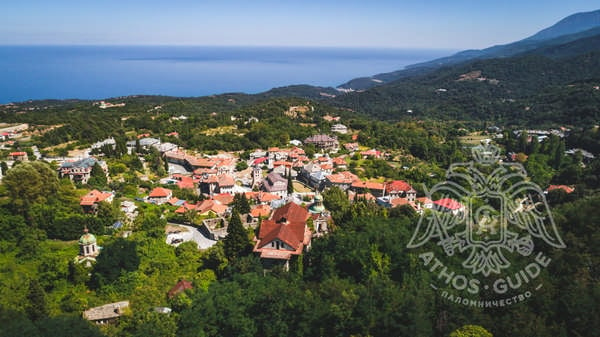
Karyes, the capital of Mount Athos, is located in the center of the Athonite peninsula.
It is the seat of the Protos, who used to have special and very important duties. He had to represent Mount Athos before all authorities, especially the Emperor, the Patriarch, the Judge and the Metropolitan of Thessaloniki, to preside over the assemblies and the council of the abbots, to be responsible for the maintenance of the monasteries, to distribute grants and to act as an organ of justice, as well as to appoint the next abbot if the monastery itself was unable to fulfil this election. The Protos confirmed the election of the abbots of all the monasteries, with the exception of the Monastery of Great Lavra, while he was responsible for the moral character of all the monks. He would also give his permission if an abbot needed to leave the territory of Mount Athos.
The representatives of nineteen of the twenty monasteries of the Athonite state live in Karyes, in buildings that are called konakia.
The central church of Karyes is the church of the Protaton, dedicated to the Dormition of the Virgin Mary. The frescoes of the church are a work of Manuel Panselinos, the main representative of the Macedonian school of iconography.
In Karyes there is also the miraculous icon of Theotokos Axion Esti. The icon took its name from the Archangel Gabriel himself who first chanted the hymn of Axion Esti before Theotokos.
Next to the church of the Protaton there is a tower, as well as the Athonite Academy, the administration of Mount Athos, various authorities and services such as police buildings, a medical treatment room, a post office, a bakery, shops with ecclesiastical goods and monastic cells.
At the beginning of the 10th century there was already a settlement in this place, called "Mesi" (Middle). The church of the Dormition of the Virgin Mary was originally quite small. Around 960 it was demolished and a new spacious cathedral was built in its place. Its frescoes were completed around 1300 and are considered to be traditional works of the legendary Panselinos.
The tower houses an archive with many documents, including the "Typikon", statutes of 972 and 1045, authenticated with the signatures of the emperors John Tsimiskis and Constantine Monomachos respectively.
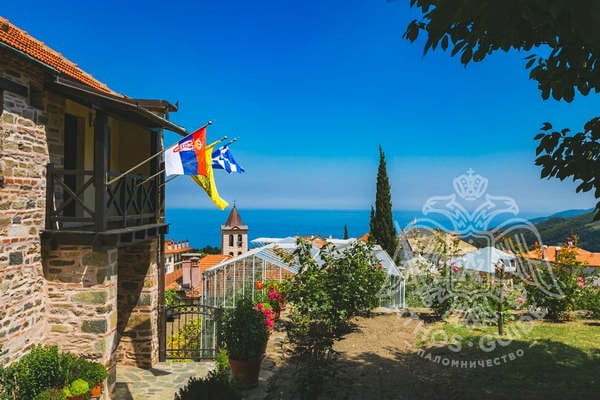
From the 17th to the 19th century, the tower was the residence of the Turkish Agha. At that time, it was also used as a prison for all sinners (laymen and monks).
The place was known as some kind of settlement near the Xerxes Canal. This is confirmed by the seal of the Emperor Leo VI the Wise, who calls the area "Palaia" (Old). The Monastery of Koutloumousiou and the Skete of Saint Andrew are five minutes away from Karyes.
Urban structure of Karyes
About fifty permanent residents make up the population of the town of Karyes. Mount Athos, the smallest state, has internationally recognized autonomy and its own charter.
On the eastern side of the peninsula, on slopes covered with beech and chestnut forests, overlooking the North Aegean Sea, there is a small urban complex consisting of administrative buildings, the "konakia" that are representative offices of nineteen of the Athonite monasteries (the Monastery of Koutloumousiou does not have a konaki due to its proximity).
The administration system with the participation of representatives of all monasteries, resembles the parliament of each state.
In the center of Karyes there are the administrative institutions: the Holy Community and the Holy Epistasia, the 'parliament' and the 'government' of Mount Athos. They decide on everything concerning the Athonite state. Directly in front of the building of the Community there is the famous church of the Protaton with the frescoes of Manuel Panselinos. The icon of Axion Esti is also kept there, while a little further on there is the representative of the Greek authorities - the Commander, responsible for public orders, security and generally for the execution of state laws on the Athonite peninsula.
Life in Karyes
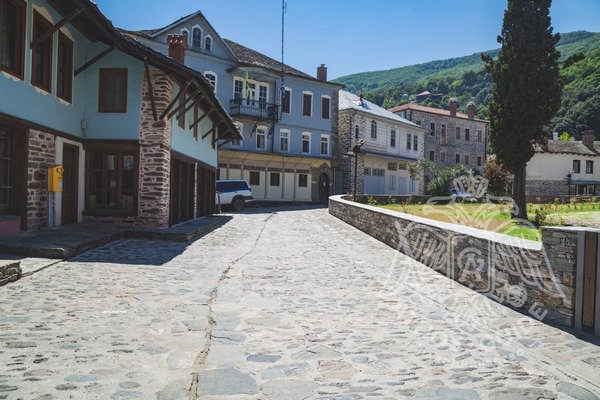
Daily life in the town begins at the first sunlight and ends at sunset, when, according to the rules of Mount Athos, all activity ceases and the monks retire to their cells in order to pray and rest from the manual labor of their monastery's agricultural work. When the sun leaves behind Mount Athos to sink into the waters of the Aegean, Karyes is already empty. None of the monks or laymen, hired for technical work, are allowed to walk around the central square and the streets of the capital.
Early in the morning the city wakes up and a new day begins. Monks arrive in trucks and cars from all over the peninsula, along rough forest roads, accompanied by clouds of dust, to shop for the monastery and complete their duties. Transfers to Athos, buses with ten or twelve seats, driven by monks or laymen, carry pilgrims to the port of Daphne. Some wait in the parking lot to "load" food and medicine for the monasteries and sketes that are isolated, as well as for hermit monks.
Pilgrims in Karyes
More than two hundred thousand people pass each year through this small transit center to make a pilgrimage to the monasteries of Mount Athos. They are ordinary orthodox christians, as well as celebrities that recognize the importance of this holy place.
Kings, princes and patriarchs have been here more than once. World power leaders have walked in the central square of Karyes, have worshipped the icon of Theotokos Axion Esti and enjoyed the traditional tsipouro and loukoumi treat in the reception hall of the Holy Community. George Bush, Colin Powell, Vladimir Putin, Jacques Delors, the then Prince Charles of England (now King), descendants of the Romanov dynasty, Slobodan Milosevic and all Greek Presidents and Prime Ministers have visited Mount Athos more than once.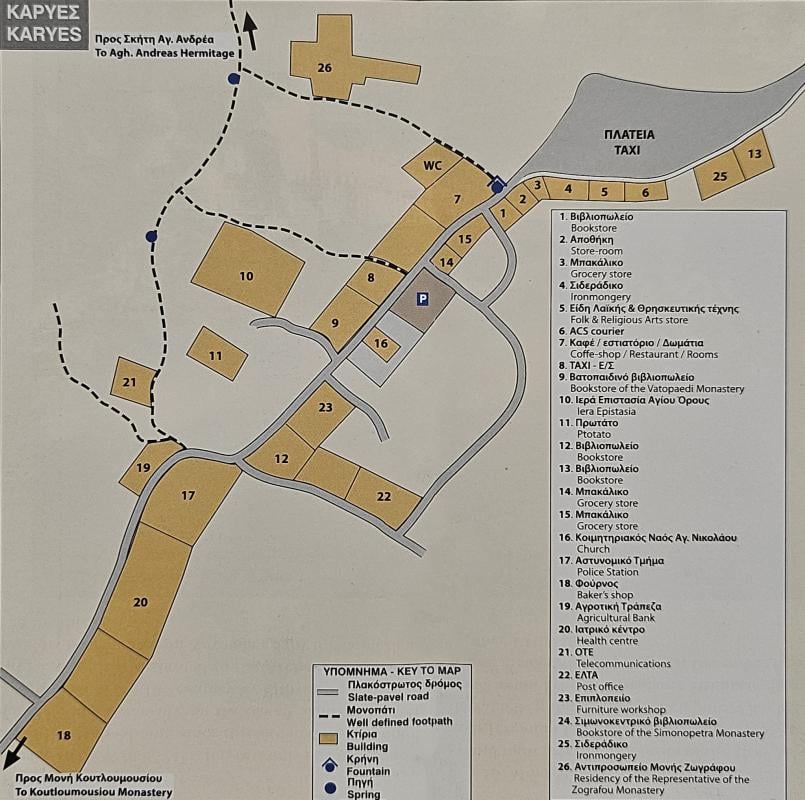
This continuous human movement could not but favor the establishment of market relations in everyday life, with the same working rules as in the outside world, despite the fact that Mount Athos society is often referred to as a world of "angels in human form".
In Karyes, there are no signs or street names. However, there is a street called “the Holy Spirit”, which is the main shopping street, about a hundred metres long, leading to the central square of the Portaton. There are more than twenty shops selling T-shirts, braided bracelets, icons, knives and many other items.
In addition to sandwiches, cheese pies and croissants, the owner of the snack bar in the square offers fresh coffee, the traditional coffee from Mount Athos. He also operates and maintains two taxis with the permission of the Holy Synod.
Not far, a fellow resident rented a restaurant from the Zograf Monastery, where he has been working for the last twenty-five years. The top floor of the restaurant houses a four-room hotel. The owner works until eight o'clock in the evening, when everything closes. There they cook meat for the lay people on non-fasting days.
With such a large number of people, Karyes could not be deprived of medical, pharmaceutical and banking support. Our pharmacist tells us that in Mount Athos pilgrims widely use medicines for illnesses related to drug and alcohol addiction. This is not surprising, as addicted people come to Mount Athos in the hope that with the help of the monks they will overcome their problem.
Eight doctors offer services at the Karyes Health Centre. Monks maintain a healthy lifestyle. Their ailments are usually arthritis and back pains caused by physical work. Varicose veins due to standing on vigils are also common.
Поликлиника, аптека, полиция, а также банк — все это необходимые для любого города учреждения. В афонском банке, однако, не выдают кредитов, но выплачивают пенсии монахам и мирянам, которые по разным причинам оставались в монастырях на длительный срок. Банки существовали на Святой Горе и в прошлые века.
Karyes Today
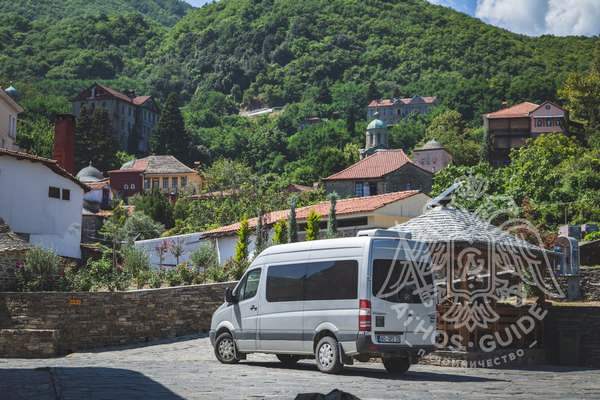 "In the last decades of the 19th century, the Athonite capital was bustling with life, while its market was experiencing its heyday. The inevitable consequence of this was the influx of popular traders, buyers and visitors, whose noisy presence in the motels and distilleries of Karyes caused great concern in the Patriarchate in Constatinople” – such notes are found in old travel books of Karyes in the 19th century.
"In the last decades of the 19th century, the Athonite capital was bustling with life, while its market was experiencing its heyday. The inevitable consequence of this was the influx of popular traders, buyers and visitors, whose noisy presence in the motels and distilleries of Karyes caused great concern in the Patriarchate in Constatinople” – such notes are found in old travel books of Karyes in the 19th century.
Today, given the effects of globalization and the dizzying pace of the technological revolution on a global scale, the need to preserve the spiritual character of the Athonite life is more urgent than ever.
The central square of the Protaton is a prominent symbolic place where the spiritual mentality converges with the daily needs of the population of Mount Athos. However, at the same time it is also the place most exposed to the challenges of the outside world.

